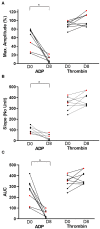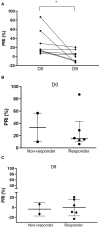Assessment of P2Y12 Inhibition by Clopidogrel in Feline Platelets Using Flow Cytometry Quantification of Vasodilator-Stimulated Phosphoprotein Phosphorylation
- PMID: 32537460
- PMCID: PMC7267589
- DOI: 10.3389/fvets.2020.00267
Assessment of P2Y12 Inhibition by Clopidogrel in Feline Platelets Using Flow Cytometry Quantification of Vasodilator-Stimulated Phosphoprotein Phosphorylation
Abstract
The primary objective of this study was to evaluate a novel flow cytometry-based assay of quantifying platelet phosphorylation of vasodilator-stimulated phosphoprotein (P-VASP) in cats that received clopidogrel treatment. Eight healthy cats received 18.75 mg PO q24h of clopidogrel for 7 days. Prior to and after clopidogrel treatment, blood was collected for ADP-induced light transmission aggregometry (LTA) and P-VASP measurement by flow cytometry. Flow cytometry measurement of P-VASP levels was used to derive platelet reactivity index (PRI) before and after clopidogrel treatment. Based on P-VASP and LTA findings, platelet response to ADP was significantly attenuated after 7 days of clopidogrel treatment. By eliciting the competing platelet pathways of P2Y12 and cAMP using ADP and PGE1, respectively, ADP had no effect on P-VASP levels following clopidogrel treatment (p = 0.94). Clopidogrel also significantly decreased PRI from 28.84 ± 28.52% to 1.69 ± 12.39% (p = 0.0078). PRI on day 8 correlated moderately with the degree of slope inhibition on LTA (r = -0.4, p = 0.4). Flow cytometry analysis of P-VASP is effective at monitoring the inhibitory effects of clopidogrel on feline platelets.
Keywords: cyclic AMP; hypertrophic cardiomyopathy; light transmission aggregometry; platelet activation and signaling; vasodilator stimulated phosphoprotein.
Copyright © 2020 Li, Nguyen, Rosati and Jandrey.
Figures




References
-
- Atkins CE, Gallo AM, Kurzman ID, Cowen P. Risk factors, clinical signs, and survival in cats with a clinical diagnosis of idiopathic hypertrophic cardiomyopathy: 74 cases (1985-1989). J Am Vet Med Assoc. (1992) 201:613–8. - PubMed
LinkOut - more resources
Full Text Sources
Miscellaneous

